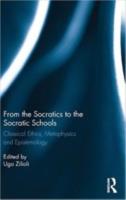
Routledge (2015) h/b 216pp £85 (ISBN 9781844658435)
The impact of Socrates can be measured by the golden age of philosophy that followed his death: apart from Plato and Aristotle in Athens, schools sprung up in Megara, Elis, Eretria, and Cyrene. This collection of essays, arising from a conference in 2013, turns the spotlight on these Socratic schools and their relationship to Socrates and his pupils, the so-called Socratics.
The first chapter sets the ball rolling by using Plato to identify who the Socratics were and in the process shows that the very concept of a Socratic is hazy at best. This sets the tone for the volume as a whole, which frequently invites the reader to examine their own assumptions. For instance what exactly is a philosophical school? Or indeed what is a Socratic school, given the wide divergence of views entertained by different individuals?
The pleasure-loving Cyrenaics are covered over the course of three chapters. Were they sceptics who denied that any knowledge of the external world is possible? Or did they have a clear view that the external world was by its very nature indeterminate? In contrast, the ascetic school of Antisthenes receives two chapters, espousing the existence of moral knowledge in Socratic fashion but then having to deal with the possibility of educational failure. A chapter each is devoted to Phaedo, Aeschines, Diodorus, and Pyrrho. Another chapter considers newly edited papyri that indicate Epicurean criticism of the Socratics.
The chapter on Phaedo (the man, not the Plato dialogue) will be of particular interest to those readers with a broader interest in the Greeks: the beautiful youth (whose hair Socrates enjoys stroking) sets out in his lost dialogue Zopyrus to reveal Socrates’ inner self. The end result is a Socrates who does nothing to establish any doctrines but instead reveals through his behaviour a rule of life inspired by self-control.
As one would expect from essays by leading scholars in the field, much of the discussion is technical and oriented to a specialist readership but, refreshingly, prior knowledge of the modern scholarship is not assumed, and the different positions adopted by the experts are set out clearly. The book’s stated aim of filling in some gaps in our knowledge of these philosophers is well served.
Alan Towey—Holmewood House School
